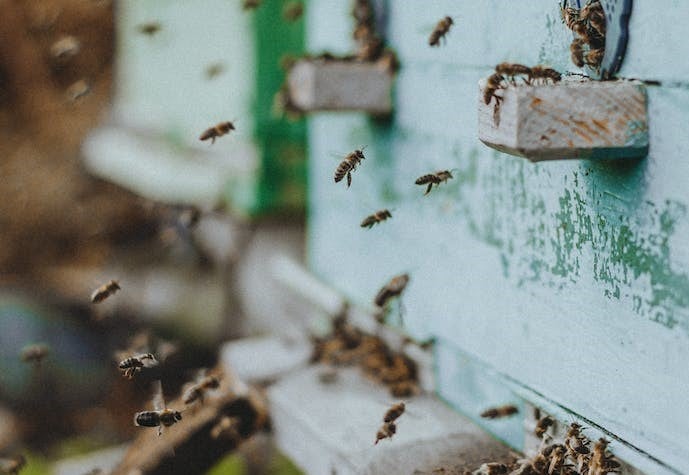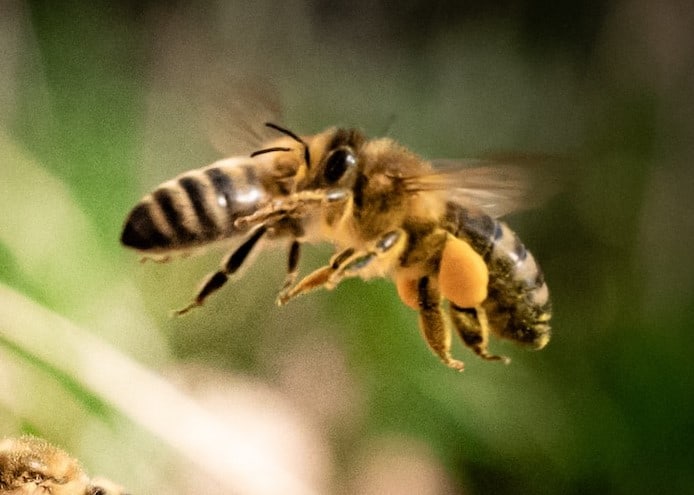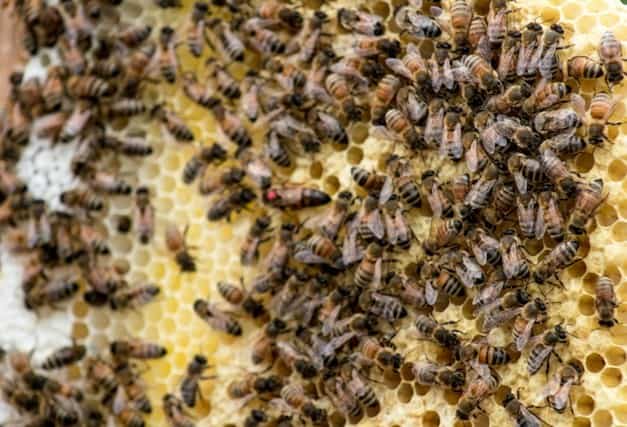When we talk about honey bees, what first comes to mind are the industrious worker bees and the queen. Drone bees are quite unheard of.
Worker bees are the industrious bees that forage for nectar and pollen. The queen populates the hive and rules the bees to keep the colony thriving.
Drone bees are not paid much attention. Yet, a drone bee plays a vital role in the colony and in beekeeping.
In this blog post, let’s discover the significant roles that drone bees play in the hive.

What Are Drone Bees?
There are three types of honey bees in a colony: the queen, drones, and worker bees. The queen bee and the worker bees are female bees, while the drones are male bees.
Drone bees are male honey bees. Compared with other bees in the colony, they are bigger in size compared to worker bees and have larger eyes.
A drone bee may be shorter than a queen bee. However, this male honey bee has a stockier body compared to a honey bee queen or any worker bee.
The drone’s larger abdomen ends somewhat bluntly, not a soft, pointed tapering as seen on workers and the queen. Unlike these female bees, a drone bee does not have a stinger.
How Are Drone Bees Born?

Both the queen and the worker bees are born out of fertilized eggs. On the other hand, drone bees are born from unfertilized eggs. They are born without the female bee having been mated.
Since the drones develop from unfertilized eggs, they have only one set of chromosomes, making them haploid.
This characteristic allows for a more efficient reproduction process in bees. When a drone mates with a queen, it contributes its haploid genetic material to the queen’s offspring, resulting in genetic diversity within the hive.
As drone eggs are unfertilized, it is not only the queen bee that can lay these eggs. Worker bees are also able to lay unfertilized eggs that would hatch into drone bees.
The queen and egg-laying worker bees would lay drone eggs in drone cells inside the hive. The drone cells are usually bigger than worker brood cells. When a queen or worker bee sees a much larger brood cell, it is a sign for her to lay an unfertilized egg in that cell.
A drone egg in a drone cell would develop into a drone brood, which will give way to the birth of a male bee in around 24 days.
During the larval stage, bee larvae are fed royal jelly for 2-3 days. Then, they are fed bee bread to support the drone’s development.
Drones that get to mate with a queen die after mating. Those who were not so lucky as to get a queen mated would die sometime soon. The average lifespan for a drone bee is about 30 days. However, they can live up to 60 days, and in some cases, reports have noted that they can survive up to 90 days.
What Do Drone Bees Do?

There is only one major purpose for which the drone bee is born — to mate with a queen to promote reproduction. They live and exist to mate with virgin queens, after which they are happy to have served their purpose and die.
Sexually mature drones fly above ground in what is known as the Drone Congregation Area (DCA). The Drone Congregation Area can be as wide as 200 meters and as high as 30 meters above the ground.
The Drone Congregation Areas would usually be safe from winds and other forces of nature that could impede flying. Studies have shown that environmental conditions in the DCAs affect the mating behavior of honey bees.
These male bees would usually gather at DCAs near apiaries. In there, drones spend most of their time flying and waiting until a virgin queen flies within the area.
The Role of Drone Bees in the Colony
In order for the honey bee colony to survive, it needs a queen, workers, and drones.
The queen is needed to produce more workers that would tend the hive. Workers are necessary to forage and gather food for the whole bee colony. And drones are needed to mate with the queen to produce a new queen when the time for the old queen to retire comes.
As workers are also female bees not born to be queen bees, they come from fertilized eggs as well, which need the interference of drones to lay eggs and reproduce.
Reproduction
Without the drones, a queen bee would not be mated and could not lay fertilized eggs that would produce more female or worker bees.
Without drone bees, a honey bee colony would also have no queen (queenless). The colony would ultimately die unless a new queen was introduced to the hive.
During mating flights, a drone honey bee successfully mates with a virgin queen and transfers his genetic material to her. Drones die after mating, but their contribution to the survival and evolution of the bee colony lives on through the queen’s fertilized eggs.
The moment a queen comes within the DCA, a swarm of drones rapidly follows behind her. With massive flight muscles, drone bees pursue and try to mate with her in what is known as the mating flight. The fast and strong drone bee mates with the queen once he catches up with her. The actual mating process is quick, lasting for about 5 seconds, after which the drone pulls away and dies shortly.
On the other hand, the queen is capable of multiple mating with other drones. She would continue roaming within the DCA and would successfully mate with multiple drones a few more times. The drones would stop pursuing the queen once she flew out of the DCA.
Other Roles They Play
Drones help regulate the temperature within the hive. Their sole presence generates heat through their body temperatures, making the hive more conducive for developing brood cells.
Also, drones help in warding off predators that come near the hive. Despite the lack of stingers, they are seen as threats by potential predators because of their large bodies.

Final Thoughts
Drone bees may not gather nectar, build honeycombs, or perform other tasks undertaken by their female bees for producing honey.
However, their purpose in mating and contributing to the genetic diversity of honeybee colonies is vital.
By understanding what drone bees do, we get a better understanding of their important roles in a healthy hive.
So, the next time you see a group of bees congregating during warm and sunny afternoons, do not disturb them. They may just be waiting for a receptive queen to take her nuptial flight.
Did You Miss These Beekeeping Posts?
